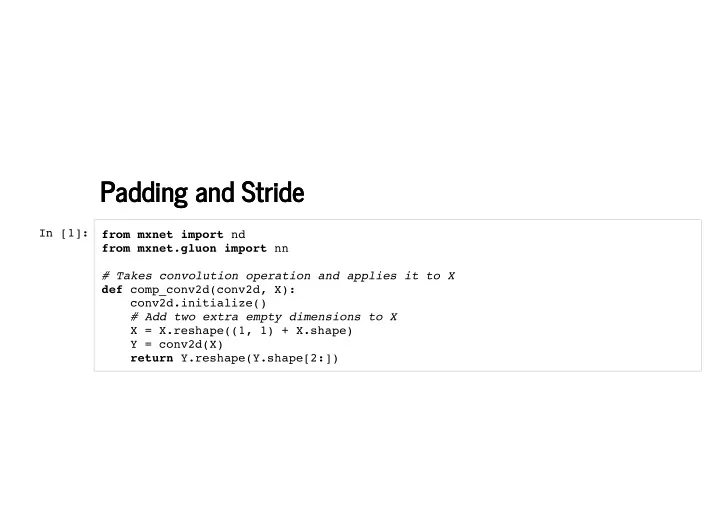

2/23/2019 padding-and-strides slides Padding and Stride Padding and Stride In [1]: from mxnet import nd from mxnet.gluon import nn # Takes convolution operation and applies it to X def comp_conv2d(conv2d, X): conv2d.initialize() # Add two extra empty dimensions to X X = X.reshape((1, 1) + X.shape) Y = conv2d(X) return Y.reshape(Y.shape[2:]) http://127.0.0.1:8000/padding-and-strides.slides.html?print-pdf/#/ 1/3
2/23/2019 padding-and-strides slides Padding Padding In [2]: conv2d = nn.Conv2D(1, kernel_size=3, padding=1) X = nd.random.uniform(shape=(8, 8)) # Padding of 1 leaves shape unchanged for 3x3 convolution comp_conv2d(conv2d, X).shape (8, 8) Out[2]: Strides Strides In [3]: conv2d = nn.Conv2D(1, kernel_size=3, padding=1, strides=2) comp_conv2d(conv2d, X).shape (4, 4) Out[3]: http://127.0.0.1:8000/padding-and-strides.slides.html?print-pdf/#/ 2/3
2/23/2019 padding-and-strides slides Asymmetric kernels, padding and strides Asymmetric kernels, padding and strides We can use different strides, different kernel sizes and different padding for height and width. This can be used, e.g. to adjust the size to a desired shape (4:3 to 1:1). In [4]: # pad only vertically and use different strides on the 8x8 image conv2d = nn.Conv2D(1, kernel_size=(3, 5), padding=(0, 1), strides=(3, 4)) comp_conv2d(conv2d, X).shape (2, 2) Out[4]: http://127.0.0.1:8000/padding-and-strides.slides.html?print-pdf/#/ 3/3
Recommend
More recommend